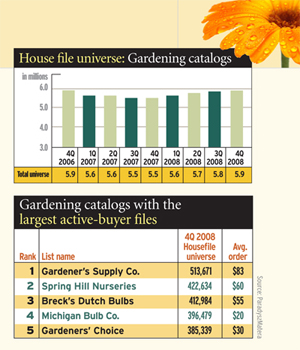
The holiday season is over (thank heaven). It’s time to barrage gift recipients with catalogs and e-mail messages, right?
Not so fast. You may be trying to recover from dismal holiday sales. But giftees can be the toughest prospects to tackle, according to Melissa Watson, director of catalog and e-mail marketing for gifts retailer Harry & David.
Why? Unless you already have the name in your house file, you won’t have the necessary demographic and psychographic data.
“We do not have all the same information on the gift recipients as we do the buyers,” Watson said last May during a session at the ACCM show. “We know what they bought, when they bought it, and why. With recipients, you just know the name and address of the person who received the gift.”
But that doesn’t mean it’s an impossible task. Harry & David uses a regression model on its giftees, then applies outside models on top of that to determine what would make them want to buy, Watson says.
L.L. Bean treats consumers who receive gifts as it would a prospect who makes a purchase or requests a catalog, says its vice president of e-commerce Chris Wilson.
But you need to ask yourself some questions before you reach out to these lucky people.
First, find out if the person is responsive to direct mail, says Anna-Lisa Ulbrich, senior circulation and marketing manager at catalog consultancy Lenser. If your universe is large enough, Ulbrich suggests sending the names that are not currently in your house file to the co-ops so you can learn a little more about them.
“If you are J. Jill and you have a giftee who received a sweater, you want to know whether or not this recipient responds to direct marketing offers,” Ulbrich says. “For that matter, you want to find out if the customer even buys women’s apparel.”
Gina Valentino, president of catalog consultancy Hemisphere Marketing, agrees with that philosophy.
“Let’s say you’re L.L. Bean and you get these new names,” Valentino says. “They should be cross-checked to see if they’ve bought from Cabela’s or Bass Pro Shops.” (For more on the topic from Valentino, see “Sizing up situational circ changes” on page 26.)
Timing is everything
Timing can be an issue with giftees. Let’s say your business is selling gift items in the fourth quarter. There’s no sense exhausting the name before your peak sales season hits.
When should you mail the person? During the next holiday season, Ulbrich says.
But that’s not true for a merchant with a year-round business. You may want to hit the giftees once in January and then again in February, and see how they respond.
For that matter, January may even be a little late. Valentino is a fan of including a catalog as an insert with the gift. The giftee will be wowed by the present and is more likely to make a purchase from you.
Valentino is surprised that some merchants refuse to do that for giftees. Their theory is that the person will find out how much the giftor paid for the present.
But that’s old-school thinking, given that prices for pretty much everything can now be found online.
And don’t forget to send a catalog to the ship-to address, especially if it’s a business address and the billing address is residential.
You may not want to mail these addresses all year. But try it during the holiday season once. Many of those catalogs will go from the mail room to the recipient, then to the lunch room — meaning they’ll be read by more potential buyers.
And the person who sent the gift? Handle this customer with care, especially if he or she is a first-time buyer, Ulbrich says.
“You know even less about the giftor,” she adds. “Perhaps the customer doesn’t buy from the cataloger outside the fourth quarter, or maybe doesn’t ever shop that segment at all.”
MARKET SNAPSHOT: GARDENING UNIVERSE BLOOMS

THE ECONOMY MIGHT BE WILTING, but the gardening catalog market segment — which includes purveyors of seeds, bulbs, plants and trees, gardening tools, outdoor decor and gift items — has seen surprising growth during the past year.
According to list brokerage services firm ParadyszMatera, the segment has grown by about 5.5%, or 303,000 names, since the fourth quarter of 2007, reaching 5.9 million names by the end of the fourth quarter of 2008. This helped make up for lost ground in 2007: From the fourth quarter of 2006 to the fourth quarter of 2007, the segment dropped from 5.9 million names to about 5.5 million names.
Dominating the segment is Gardener’s Supply Co., with 513,000 names. Rounding out the top five are Spring Hill Nurseries, with 422,000 names; Breck’s Dutch Bulbs, with 413,000 names; Michigan Bulb Co., with 396,000 names; and Lipenwald’s Gardeners’ Choice, with 385,000 names.
Some of these merchants have seen significant growth in their house files during the past year. For example, Gardeners’ Choice gained 115,000 names; Spring Hill is up 69,000 names; and Gardener’s Supply increased its file by 35,000 names.
